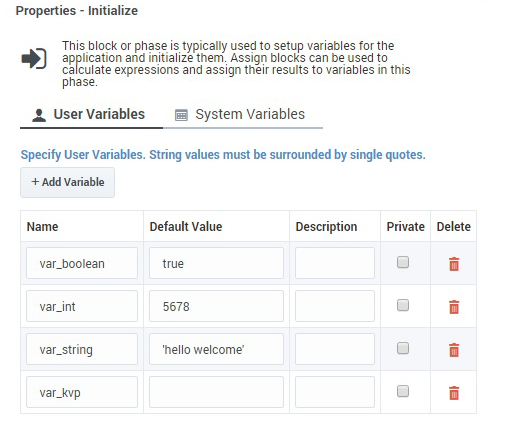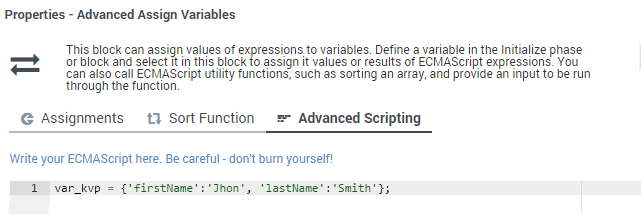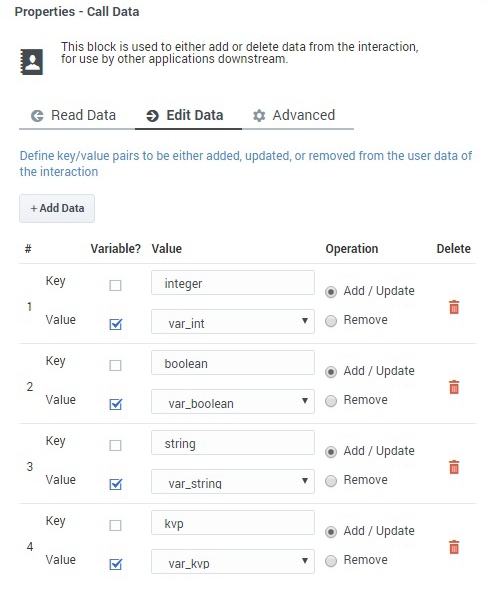Call Data Block
Contents
- Non-variable key names must follow standard JavaScript rules for variable names, even if the keys are not variables. For example, key names must:
- Not contain spaces.
- Only contain alphanumeric characters.
- Not use a restricted variable name (see the Restricted Variable Names section, below).
- Call data cannot be deleted. The Edit Data tab does not have the Remove option, as is available in the Assisted Service phase.
You can use the Call Data block to read and write data that can be accessed from both inside and outside the application.
The data format consists of key-value pairs (KVP). That is, for every key in the call data, you can associate a value with it. This value can be be an integer, character string, binary (boolean) type, or as a list of KVPs. (See an example of how to do this.)
About key-value pair lists: When a key-value pair list is used as a value in the user data for a Call Data block in the Self Service phase, the user data is attached to the call, but the platform encodes any special characters that appear in the user data, such as single quotation marks ('), double-quotation marks ("), backslashes (\), commas (,), colons (:), semicolons (;), and so on.
While data in application variables only exist within the application, information stored in Call Data can persist and be retrieved even after the application finishes running. This is useful for retrieving information about the call that was created before the application started running, or for saving some information about either a caller or a call to a database so that it can be processed later by another application.
The addition, updating, and removal of Call Data do not happen instantaneously while the application is running. That is, the application starts the operation to edit the Call Data, and then continues to the next block, without waiting for confirmation that the Call Data is successfully modified.
For this reason, Genesys recommends that you do not write a key-value pair and then attempt to read back the same key from the Call Data within an application. There is no guarantee that the write operation has finished, so a read operation could potentially give you either an old value or an updated value on different runs through the application.
Instead, if you need to access a Call Data value that was already edited within the application, Genesys recommends that you use the corresponding application variable.- See the Restricted Variable Names section, below, for a list of variable names that must not be updated by the Call Data block.
- You must escape quote characters in values by using a preceding backslash. For example:
- Incorrect: Joe's Pizza
- Correct: Joe\'s Pizza
- The Call Data block only accepts string type keys and values, so you do not need to enclose these values in single quotes.
Read Data tab
Use the Read Data tab to specify keys to be read from Call Data and stored into application variables. You can toggle the key being read between a variable and a string.
Edit Data tab
If this block is in the Self Service phase, use the Edit Data tab to specify key-value pairs to be written to the call data.
If this block is in the Assisted Service phase, use the Edit Data tab to specify key-value pairs to be written to the call data, either by adding data with new keys (Add/Update operation), updating data for existing keys (Add/Update operation), or deleting data for existing keys (Remove operation):
- Add/Update - Add or update data with the specified key. This operation automatically adds the key-value if the specified key does not yet exist in the Call Data, or, if the provided key does exist in the Call Data, it automatically updates data for the key. You can toggle both the key and the value independently between a variable and a string.
- Remove - Provide the key for data you want to delete, which you can toggle between a variable and a string. At runtime, if the key you try to delete does not exist, nothing happens.
You can also add a list of key-value pairs by selecting a variable that holds key-value pairs in a JavaScript object.
Advanced tab
If this block is in the Assisted Service phase, use the Advanced tab to add an extension as a key-value pair to the key. Click Add Extension Data to add an extension as a key-value pair to this block. The value type can be a string or integer.
If you want to use a variable for the Key or Value, select the Variable checkbox and then select a variable from the drop-down menu. If the Value is an integer, select the Integer checkbox.
- Incorrect: Joe's Pizza
- Correct: Joe\'s Pizza
Example
This example shows a few different ways that key-value pairs can be added as extensions:
Scenarios
If you want to:
- Read the key userphoneno into application variable phoneno that you have previously created:
- In the Read section, click Add Key.
- Disable the Variable? check box.
- In the Key field, enter userphoneno.
- In the Store in Variable drop-down menu, select phoneno.
- Add the key segment with the value from the application variable custsegment that you have previously created:
- In the Edit section, click Add Data.
- Click Add/Update.
- Disable the Variable? check box for Key.
- In the Value field for Key, enter segment.
- Enable the Variable? check box for Value.
- In the Value drop-down menu for Value, select custsegment.
Restricted Variable Names
The following variable names are used by the Designer application and must not be updated by the Call Data block.
- _CB_N_CUSTOMER_ABANDONED_WHILE_WAITING_FOR_AGENT
- _CB_SERVICE_ID
- _CB_T_CALLBACK_ACCEPTED
- _CB_T_CUSTOMER_CONNECTED
- _CB_T_SERVICE_START
- _COMPLETE_CS
- _SEND_FINAL_UE
- CustomerSegment
- EXECUTION_MODE
- GMS_UserData
- gvp-tenant-id
- gsw-ivr-profile-name
- GSYS_IVR
- GSYS_SystemApplicationDisposition
- IApplication
- IApplicationVersion
- IPurpose
- orsurl
- orssessionid
Example
This shows how you can assign the value of a key-value pair in the Call Data block to a variable in the Assisted Service phase.
First, initialize your variables as various data types (integer, character string, binary [boolean], and so on), and create a variable for your KVP (in this example, we are using var_kvp):
Next, initialize a variable as a list of kv-pairs using the Assign Variables block. This example shows this using an ECMAScript on the Advanced Scripting tab:
Finally, add the user data as a kv-pair in the Call Data block:





